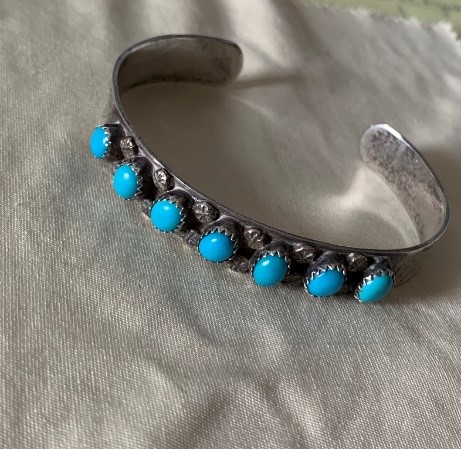Objects in collections always reflect the “gaze” of the collector, whether an individual or a museum. It is the interest, motivation, or focus of that particular collector that defines an acquisition and thus positions it within the larger context of the collection. In some cases, that position may be ambiguous, fluid, or shifting over time, defying easy categorization. A fresh perspective on such an object, based on observable attributes or evolving knowledge about it, may reveal new, more complex, more nuanced themes, categories, and meanings for it. The collection expands and grows internally.
An object I have selected to demonstrate this type of analysis is a silver and turquoise cuff bracelet marked PD COONSIS. The bracelet comfortably fits a medium to small adult wrist, though it is probably too small for an average man. The band is 3/8 inch wide and decorated with engraving, stones, and applied silver disks. The engraving is a chain of connected arcs, six per side. Seven cabochon turquoise stones are set in deep dentated bezels separated by 12 tiny silver disks. The turquoise stones are virtually identical in size and color, an unblemished clear blue. Taken altogether, the bracelet is perfectly symmetrical. The white metal is not identified by a mark, yet its patina and provenance suggest it is indeed sterling standard, i.e., 92.5% pure silver.pd
The bracelet is marked PD COONSIS, the mark of Paylee and Darlene Coonsis, prolific and well-known Zuni Pueblo designers most active from the 1940s – 1970s. The Coonsis family is still making fine metal and stone jewelry and wearable art in both traditional and contemporary Zuni styles to this very day.
This bracelet resists categorization and would be at home in many different types of collections. It simultaneously represents jewelry, lapidary, Native American enterprise, Zuni art and history, American Southwest design, and New Mexico “trading post” tourism of the mid-20th century. Recognizing and naming the bracelet’s multiplicity of positions in this way may reveal the object’s interconnected themes and meanings, any one of which is as true and defining of it as any other. So to understand this object as fully as possible requires all of these meanings to be acknowledged and explored. Anything less limits the material reality of its existence and thus constrains its meaning and value for both scholars and collectors. If we define it only as jewelry, we fail to see the Zuni history in it. If we see only Southwest design in it, we miss the social history of White tourism in the American Southwest, its explosive expansion made possible by middle-class pleasure travel and its profound economic impacts for Native American artists and communities and the region as a whole.
Take a moment now to look at your own collections with fresh eyes. Appreciate each item’s potential for categorical ambiguity. Look for new angles in long-familiar objects and spice up your relationship to your established collections.

